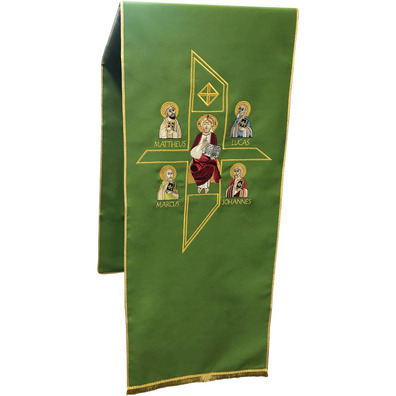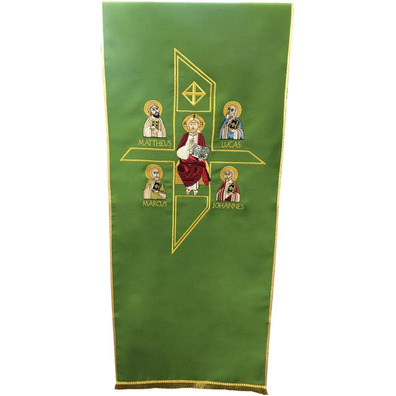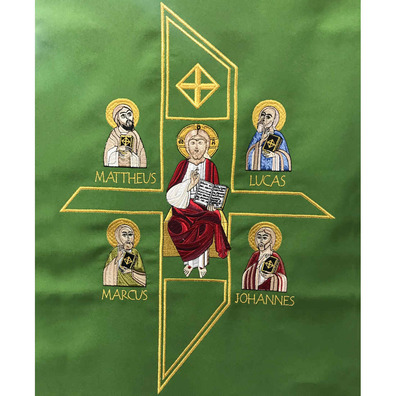Altar Lectern Cloth | Byzantine Style embroidery green
Lectern Cloth | Embroidery of the Four Evangelists
- Pulpit cover made of 100% polyester.
- Available in liturgical colors: red, green, beige, and purple.
- Elegant (gold-colored) edging on the border.
- Finished with a (gold-colored) beaded fringe.
- 49 cm. width.
- 245 cm. total length.
Embroideries of the pulpit cover
The lectern cloth is richly embroidered with (three) elements of profound significance.
- Embroidery of Christ Pantocrator in the Byzantine style
The central part of the lectern cloth is embroidered with a representation of the figure of Christ Pantocrator, following the aesthetics of the Byzantine school.
Byzantine art is an artistic style that developed in the Eastern Roman Empire and spread throughout the Christian world, especially in the Eastern Mediterranean area.
The religious representations of the Byzantine style are characterized by their use of frontal perspective, their emphasis on spirituality, and their use of (Catholic) symbols.
The Byzantine religious images were loaded with symbolic elements for evangelization to make the Word of God known to all people. They explained the Teachings of Christ through symbols to those who needed help accessing the Sacred Texts.
One of the most characteristic images of Byzantine art is that of Christ Pantocrator. This image represents Christ as the " Almighty" or " Ruler of All," a term that comes from Greek and emphasizes Christ's majesty and divine authority.
In the embroidery of this lectern cloth, one can appreciate the main elements that can be seen in the representations of Christ Pantocrator:
- Christ seated on the throne of the world. In most representations, the figure of Christ is seated on a throne. The throne as king of the world.
- The blessing: Christ is depicted making a gesture of blessing with his right hand.
- The book in the left hand. Symbol of the Gospels, the Word of God, and divine wisdom.
- The (gold-colored) halo around the head of Christ with an inscribed Cross symbolizes his holiness and divine nature.
- Tunic of white color, the symbol of purity and divinity, and red color a representation of the shed blood and the sacrifice of Christ for the forgiveness of humanity's sins.
- Embroidery of the Four Evangelists in the Byzantine style
In each of the four corners around Christ, the figure of one of the Four Evangelists is presented. Each one holds his Gospel in his hand.
The four figures (Saint Matthew, Saint Luke, Saint Mark, and Saint John) are represented with the (gold-colored) halos, a symbol of holiness.
The Four Evangelists direct their gaze to the center of the scene where the image of Christ Pantocrator is located.
- Embroidery of the Cross
The last element that completes the embroidery is a design of a Cross embroidered in (gold-colored) thread.
The embroideries of the Christ Pantocrator in the Byzantine style and the Neocatechumenal Way
The Neocatechumenal Way is a Catholic movement of ecclesial renewal founded in Spain in 1964 by Kiko Argüello and Carmen Hernández. The Catholic Church recognizes it as an itinerary of Christian formation for adults.
The followers of the Neocatechumenal Way have found in the representations of Byzantine art a series of connection points with the teachings of Kiko Argüello and Carmen Hernández.
The Neocatechumenal Way emphasizes the figure of Christ. By representing Christ as the sovereign of the universe, the Pantocrator is one of the most important figures within the Byzantine style. It was customary to represent the figure of Christ in the most relevant places within the churches.
The Word of God is another highlighted element within the representations of Christ in the Byzantine style. The word is a fundamental element in the catechesis and liturgies of the Neocatechumenal Way.
The halo and the holiness represented in the Pantocrator remind the members of the Neocatechumenal Way of their vocation to holiness and to live according to the teachings of Christ.
The gesture of blessing can also be seen as a call to mission, something that the Neocatechumenal Way takes very seriously with its strong focus on evangelization.












